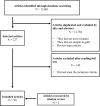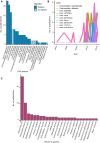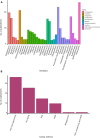The Role of Gulls as Reservoirs of Antibiotic Resistance in Aquatic Environments: A Scoping Review
- PMID: 34367104
- PMCID: PMC8343230
- DOI: 10.3389/fmicb.2021.703886
The Role of Gulls as Reservoirs of Antibiotic Resistance in Aquatic Environments: A Scoping Review
Abstract
The role of wildlife with long-range dispersal such as gulls in the global dissemination of antimicrobial resistance (AMR) across natural and anthropogenic aquatic environments remains poorly understood. Antibiotic-resistant bacteria have been detected in resident and migratory gulls worldwide for more than a decade, suggesting gulls as either sentinels of AMR pollution from anthropogenic sources or independent reservoirs that could maintain and disperse AMR across aquatic environments. However, confirming either of these roles remains challenging and incomplete. In this review, we present current knowledge on the geographic regions where AMR has been detected in gulls, the molecular characterization of resistance genes, and the evidence supporting the capacity of gulls to disperse AMR across regions or countries. We identify several limitations of current research to assess the role of gulls in the spread of AMR including most studies not identifying the source of AMR, few studies comparing bacteria isolated in gulls with other wild or domestic species, and almost no study performing longitudinal sampling over a large period of time to assess the maintenance and dispersion of AMR by gulls within and across regions. We suggest future research required to confirm the role of gulls in the global dispersion of AMR including the standardization of sampling protocols, longitudinal sampling using advanced satellite tracking, and whole-genome sequencing typing. Finally, we discuss the public health implications of the spread of AMR by gulls and potential solutions to limit its spread in aquatic environments.
Keywords: AMR; ESBL; One Health; antimicrobial resistance; bacteria; marine birds; seagulls; wildlife.
Copyright © 2021 Zeballos-Gross, Rojas-Sereno, Salgado-Caxito, Poeta, Torres and Benavides.
Conflict of interest statement
The authors declare that the research was conducted in the absence of any commercial or financial relationships that could be construed as a potential conflict of interest.
Figures




Similar articles
-
Satellite tracking of gulls and genomic characterization of faecal bacteria reveals environmentally mediated acquisition and dispersal of antimicrobial-resistant Escherichia coli on the Kenai Peninsula, Alaska.Mol Ecol. 2019 May;28(10):2531-2545. doi: 10.1111/mec.15101. Epub 2019 May 11. Mol Ecol. 2019. PMID: 30980689
-
Dirty habits: potential for spread of antibiotic-resistance by black-headed gulls from waste-water treatment plants.Environ Sci Pollut Res Int. 2024 Dec;31(58):66079-66089. doi: 10.1007/s11356-024-35551-5. Epub 2024 Nov 30. Environ Sci Pollut Res Int. 2024. PMID: 39615007 Free PMC article.
-
Urban Birds as Antimicrobial Resistance Sentinels: White Storks Showed Higher Multidrug-Resistant Escherichia coli Levels Than Seagulls in Central Spain.Animals (Basel). 2022 Oct 9;12(19):2714. doi: 10.3390/ani12192714. Animals (Basel). 2022. PMID: 36230455 Free PMC article.
-
The spread of antimicrobial resistance in the aquatic environment from faecal pollution: a scoping review of a multifaceted issue.Environ Monit Assess. 2025 Mar 25;197(4):467. doi: 10.1007/s10661-025-13860-7. Environ Monit Assess. 2025. PMID: 40131552 Free PMC article.
-
'Disperse abroad in the land': the role of wildlife in the dissemination of antimicrobial resistance.Biol Lett. 2016 Aug;12(8):20160137. doi: 10.1098/rsbl.2016.0137. Biol Lett. 2016. PMID: 27531155 Free PMC article. Review.
Cited by
-
Genetic relatedness, virulence, and drug susceptibility of Campylobacter isolated from water and wild birds.Front Cell Infect Microbiol. 2022 Nov 25;12:1005085. doi: 10.3389/fcimb.2022.1005085. eCollection 2022. Front Cell Infect Microbiol. 2022. PMID: 36506026 Free PMC article.
-
Gulls in Porto Coastline as Reservoirs for Salmonella spp.: Findings from 2008 and 2023.Microorganisms. 2023 Dec 28;12(1):59. doi: 10.3390/microorganisms12010059. Microorganisms. 2023. PMID: 38257887 Free PMC article.
-
Extended Spectrum β-Lactamase-Producing Escherichia coli from Poultry and Wild Birds (Sparrow) in Djelfa (Algeria), with Frequent Detection of CTX-M-14 in Sparrow.Antibiotics (Basel). 2022 Dec 14;11(12):1814. doi: 10.3390/antibiotics11121814. Antibiotics (Basel). 2022. PMID: 36551471 Free PMC article.
-
Qualitative Risk Assessment for Antimicrobial Resistance among Humans from Salmon Fillet Consumption Due to the High Use of Antibiotics against Bacterial Infections in Farmed Salmon.Antibiotics (Basel). 2022 May 15;11(5):662. doi: 10.3390/antibiotics11050662. Antibiotics (Basel). 2022. PMID: 35625306 Free PMC article.
-
Scolopax rusticola Carrying Enterobacterales Harboring Antibiotic Resistance Genes.Antibiotics (Basel). 2024 Mar 2;13(3):234. doi: 10.3390/antibiotics13030234. Antibiotics (Basel). 2024. PMID: 38534669 Free PMC article.
References
-
- Aberkane S., Compain F., Decré D., Dupont C., Laurens C., Vittecoq M., et al. (2016). High prevalence of SXT/R391-related integrative and conjugative elements carrying blaCMY-2 in Proteus mirabilis isolates from gulls in the South of France. Antimicrob. Agents Chemother. 60 1148–1152. 10.1128/AAC.01654-15 - DOI - PMC - PubMed
-
- Ahlstrom C. A., Bonnedahl J., Woksepp H., Hernandez J., Olsen B., Ramey A. M. (2018). Acquisition and dissemination of cephalosporin-resistant E. coli in migratory birds sampled at an Alaska landfill as inferred through genomic analysis. Sci. Rep. 8:7361. 10.1038/s41598-018-25474-w - DOI - PMC - PubMed
-
- Ahlstrom C. A., Bonnedahl J., Woksepp H., Hernandez J., Reed J. A., Tibbitts L., et al. (2019a). Satellite tracking of gulls and genomic characterization of faecal bacteria reveals environmentally mediated acquisition and dispersal of antimicrobial-resistant Escherichia coli on the Kenai Peninsula, Alaska. Mol. Ecol. 28 2531–2545. 10.1111/mec.15101 - DOI - PubMed
Publication types
LinkOut - more resources
Full Text Sources

